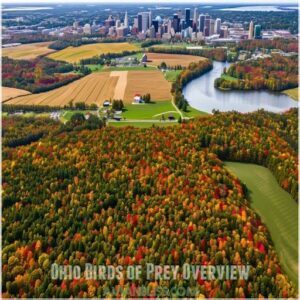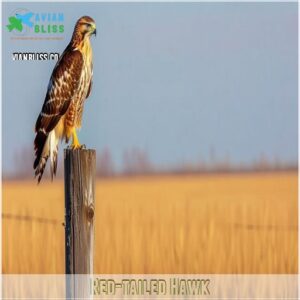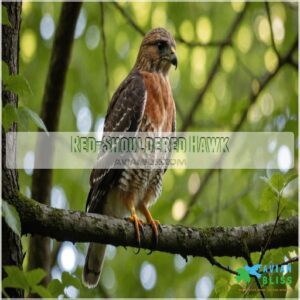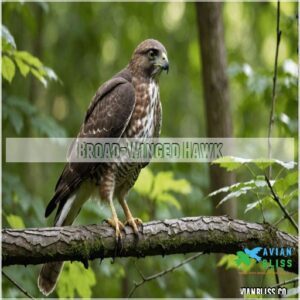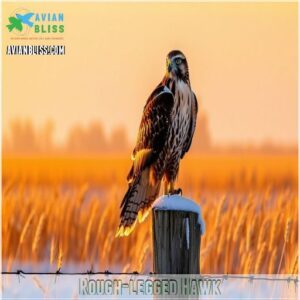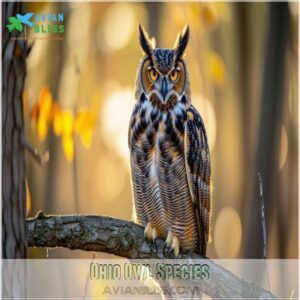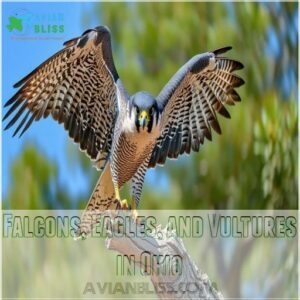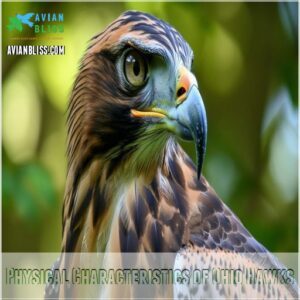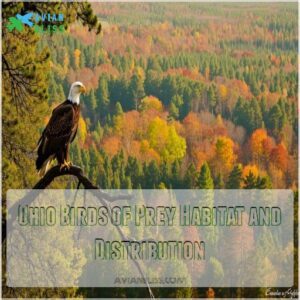This site is supported by our readers. We may earn a commission, at no cost to you, if you purchase through links.
 You’re interested in Ohio birds of prey? That’s awesome! Ohio boasts a fantastic variety, from majestic bald eagles soaring overhead to stealthy owls hunting under the cover of darkness. You’ll find powerful hawks like the red-tailed hawk, and speedy falcons like the peregrine.
You’re interested in Ohio birds of prey? That’s awesome! Ohio boasts a fantastic variety, from majestic bald eagles soaring overhead to stealthy owls hunting under the cover of darkness. You’ll find powerful hawks like the red-tailed hawk, and speedy falcons like the peregrine.
These ohio birds of prey are incredible hunters, each with unique adaptations. Think of the sheer power and grace—it’s breathtaking!
Want to know which species are easiest to spot, and where to find them? We have all the information you need.
There are some surprising facts about their hunting strategies…
Table Of Contents
- Key Takeaways
- Ohio Birds of Prey Overview
- Birds of Prey Found in Ohio
- Types of Hawks in Ohio
- Ohio Owl Species
- Falcons, Eagles, and Vultures in Ohio
- Physical Characteristics of Ohio Hawks
- Behaviors and Hunting of Ohio Birds of Prey
- Ohio Birds of Prey Habitat and Distribution
- Conservation Status and Threats
- Unique and Rare Ohio Birds of Prey
- Frequently Asked Questions (FAQs)
- What birds of prey are found in Ohio?
- Are there owls in Ohio?
- What types of birds are considered birds of prey?
- How to safely observe birds of prey in Ohio?
- Best time of year to spot hawks in Ohio?
- What equipment is recommended for bird watching in Ohio?
- How can I attract birds of prey to my backyard?
- Are Ohio birds of prey involved in migration patterns?
- Conclusion
Key Takeaways
- You’ll find Ohio home to a diverse range of birds of prey, from the majestic Bald Eagle to stealthy owls like the Great Horned Owl, thriving across its varied landscapes.
- Don’t miss the opportunity to spot raptors in action; Ohio offers prime birdwatching spots, especially during migration seasons from late September to November.
- Conservation efforts, such as those involving California birds of prey, have helped recover populations of species like the Bald Eagle and Peregrine Falcon. Supporting habitat protection and citizen science projects plays a crucial role in the conservation success stories seen with raptors like the Bald Eagle and Peregrine Falcon.
- Equip yourself with binoculars and a field guide to enhance your birdwatching experience, and consider creating an inviting habitat to attract these impressive hunters to your backyard.
Ohio Birds of Prey Overview
You’ll find 25+ magnificent birds of prey in Ohio, from the widespread red-tailed hawk patrolling farm fields to the elusive barn owl hunting at night in Amish country.
Whether you’re watching a peregrine falcon dive from a city skyscraper or spotting a bald eagle fishing along Lake Erie, you’re sure to encounter these incredible hunters throughout the Buckeye State’s diverse landscapes.
Raptors in Ohio
Anyone who’s spotted a hawk soaring overhead knows the thrill of witnessing Ohio’s raptors in action.
For those looking to dive deeper into Ohio’s birds of prey, checking out an Ohio bird of prey book can be a great starting point.
From the powerful red-tailed hawk to the elusive barn owl, you’ll find over 25 species of these magnificent birds of prey across the Buckeye State.
Whether you’re hiking the Towpath Trail or watching your backyard feeder, these skilled hunters showcase nature’s perfect balance of grace and power.
Importance of Conservation
Watching Ohio’s raptors isn’t just about the thrill of spotting these magnificent birds – it’s about understanding our role in their survival.
As their guardians, we’re part of an incredible success story.
Through efforts like bird conservation efforts today, we’ve seen significant progress in protecting habitats and reversing population decline.
From the bald eagle’s comeback to the return of peregrine falcons to our cities, your actions matter.
Every time you support habitat protection or join a citizen science project, you’re helping these incredible hunters thrive.
Birds of Prey Found in Ohio
Ohio’s skies are alive with an incredible variety of birds of prey, from the mighty Bald Eagle to the swift Peregrine Falcon. You’ll find these magnificent hunters showcasing nature’s perfect design for aerial supremacy. Whether you’re a seasoned birder or just starting out, Ohio offers prime opportunities to witness these remarkable creatures in action. To enhance your Ohio raptor-watching experience, consider checking out expert-approved gear and resources from the Ohio Raptor Guide.
Here’s what makes Ohio’s raptors so special:
- They’ve adapted to diverse habitats, from urban landscapes to remote forests
- Many species have made impressive comebacks from near-extinction
- Each raptor fills a unique ecological niche in Ohio’s ecosystem
- You can spot them year-round, with winter bringing special visitors like Snowy Owls
- They’re excellent indicators of environmental health
These powerful predators aren’t just fascinating to watch – they’re key players in maintaining the balance of Ohio’s wildlife. From controlling rodent populations to serving as inspiration for human engineering, our local raptors never cease to amaze.
Types of Hawks in Ohio
Hawks are known for their incredible adaptability, thriving in various Georgia habitats including urban and wetland areas, from the smallest Broad-winged Hawk to the largest species. You’ll find six remarkable hawk species soaring through Ohio’s skies, from the widespread red-tailed hawk to the winter-visiting rough-legged hawk.
Whether you’re watching from your backyard or hiking through the Cuyahoga Valley, you’ll spot these skilled hunters showing off their unique flying styles and hunting techniques.
Red-tailed Hawk
The majestic Red-tailed Hawk rules Ohio’s skies as our most recognizable raptor.
You’ll spot these adaptable hunters soaring over highways and perched on telephone poles, scanning for prey with their keen eyes.
As one of the state’s common birds of prey, they play a vital role in maintaining a balance between predator and prey in Ohio’s ecosystem birds of prey in Ohio.
With their distinctive rusty-red tails and powerful build, they’re true masters of the air.
Listen for their intimidating screech – it’s so iconic that Hollywood often uses it for other birds of prey!
Sharp-shinned Hawk
Have you ever spotted nature’s aerial acrobat darting through your backyard? You’re likely watching a Sharp-shinned Hawk, one of Ohio’s smallest and most agile birds of prey. These swift hunters are masters of surprise attacks, especially around bird feeders.
- Males are noticeably smaller than females, about the size of a Blue Jay
- Known for their distinctive square-tipped tail when soaring
- Primarily hunt songbirds and small mammals
- Expertly maneuver through dense forest canopies at high speeds
Cooper’s Hawk
Moving up a size from the Sharp-shinned Hawk, you’ll find Cooper’s Hawks putting on quite a show in Ohio’s woodlands.
These skilled hunters cruise through your backyard with their distinctive long tail and rounded wings, snatching birds right off your feeders.
At 14-17 inches long with a striking blue-gray back and reddish-barred chest, they’re becoming regular visitors to suburban neighborhoods.
Red-shouldered Hawk
You’ll spot Red-shouldered Hawks soaring gracefully through Ohio’s deciduous woodlands, their distinctive copper-red shoulder patches catching the sunlight. These medium-sized raptors have adapted perfectly to life near swamps and rivers.
- Wingspan stretches an impressive 37-44 inches
- Makes a loud "kee-aah" call that echoes through the forest
- Hunts like a pro for snakes, frogs, and mice
- Nests in tall trees, often returning to the same spot yearly
Broad-winged Hawk
While Red-shouldered Hawks dominate our local woodlands, their smaller cousin, the Broad-winged Hawk, brings its own charm to Ohio’s forests.
These stocky raptors stretch 13-17 inches long, with distinctive reddish-brown heads and boldly barred bellies.
Keep your eyes peeled in Cuyahoga Valley National Park, where they’re known to nest.
Their chunky build and squared tail make them look like compact powerhouses ready for action.
Rough-legged Hawk
The Arctic-dwelling Rough-legged Hawk brings winter drama to Ohio’s open fields, with its impressive 54-inch wingspan and distinctive hovering hunt style. You’ll spot these winter visitors scanning for voles and mice across agricultural landscapes.
- Their dark wing patches create a striking contrast against pale underwings
- They’ve mastered the art of hovering like a giant hummingbird
- Their feathered legs help them survive brutal Arctic conditions
- They’re one of few hawks that regularly hunt after sunset
Ohio Owl Species
You’ll find eight fascinating owl species in Ohio, from the fierce Great Horned Owl, which is also the most common owl in New York’s diverse habitats, including forests, urban areas, and grasslands like those found in New York, that rules the night to the tiny Northern Saw-whet Owl that’s barely bigger than a soda can.
Whether you’re wandering through dense forests or scanning open fields at dusk, you’re likely to spot these masterful hunters perched silently in trees or gliding soundlessly overhead.
Great Horned Owl
Meeting a Great Horned Owl face-to-face feels like encountering nature’s own security system.
As Ohio’s fiercest nocturnal predator, you’ll recognize it by those distinctive ear tufts and piercing yellow eyes that seem to stare right through you.
Known as the "tiger of the forest", these powerful hunters adapt to any environment, from deep woods to suburban parks, making their haunting calls echo through moonlit nights.
Barred Owl
Unlike their fierce cousin the Great Horned Owl, you’ll find Barred Owls watching you with curious dark eyes from dense woods near river bottoms.
They’re quite the conversationalists, famous for their "who-cooks-for-you" calls that echo through the forest.
You’ll spot their chunky bodies adorned with horizontal stripes across their wings, back, and tail.
These inquisitive owls often stick around to observe humans, making them fantastic photography subjects.
Long-eared Owl
Lurking among dense foliage, secretive Long-eared Owls challenge even experienced birders to spot them.
You’ll find these winter visitors most active at night, when their impressive camouflage matters less.
- Slender bodies and distinctive long ear tufts set them apart from other owls
- Masters of stealth, blending perfectly with tree bark patterns
- Hunt primarily in open fields and meadows after sunset
- Form loose winter roosts with up to 20 owls in single stands of evergreens
Eastern Screech-Owl
Small but mighty, the Eastern Screech-Owl could be right in your backyard without you knowing it.
These 6-10 inch owls come in two striking color phases: rusty red or silvery gray.
They’re masters of camouflage, blending perfectly with tree bark.
You’ll often hear their soft trills at dusk – a sound that’s more gentle whistle than actual screech, despite their name.
Northern Saw-whet Owl
Meet one of Ohio’s most charming woodland residents – the Northern Saw-whet Owl.
At just 7-8 inches long, these tiny hunters pack serious attitude into a pint-sized package.
They’re also one of the smallest nocturnal birds in Ohio, producing high-pitched toots that are both surprising and enchanting, as discussed in more detail on Ohio night birds.
You’ll find them roosting in dense vine tangles and conifers during winter months.
Their mottled brown plumage and distinctive white spotting make them masters of camouflage, while their large rounded heads (without ear tufts) give them an adorably fierce appearance.
Snowy Owl
Unlike our tiny Northern Saw-whet friends, you’ll be amazed by the majestic Snowy Owl.
These Arctic visitors grace Ohio’s winter landscape, measuring an impressive 20.5-27.9 inches with a wingspan reaching 57.1 inches.
Here’s what makes these ghostly hunters remarkable:
- They’re the heaviest owls in North America, weighing up to 6.5 pounds
- Their feathers are completely soundless in flight
- They hunt during daylight hours
- Males become whiter with age
Short-eared Owl
While snowy owls bring Arctic magic to Ohio, you’ll find their cousins, the short-eared owls, putting on their own spectacular show in our winter fields.
These remarkable visitors love to hunt at dawn and dusk, gliding silently over grasslands and marshes.
You’ll spot them by their distinctive butterfly-like flight pattern as they scan for voles and mice in agricultural areas and open meadows.
Barn Owl
The ghostly white Barn Owl has become a rare sight in Ohio, with habitat loss pushing these silent hunters to seek refuge in unexpected places.
Amish country offers perfect nesting spots in traditional wooden barns, where you’ll find them most often.
Their heart-shaped faces and distinctive screech make them unforgettable, but they’re facing tough times.
Conservation efforts focus on protecting their remaining strongholds.
Falcons, Eagles, and Vultures in Ohio
You’ll find Ohio’s most impressive aerial hunters in this group, similar to those in other states like Florida where over 50 species of birds of prey inhabit diverse ecosystems, including ecological balance in Florida. from the lightning-fast Peregrine Falcon that can reach speeds of 200 mph to the majestic Bald Eagle that’s made an incredible comeback with over 200 nests across the state.
Whether you’re watching a Turkey Vulture soar on thermal currents or spotting an American Kestrel hovering above a field, these birds show off nature’s perfect blend of power and grace.
Peregrine Falcon
You’ll spot these high-speed hunters perched atop Cleveland’s tallest buildings, a clear sign of their remarkable urban adaptation.
As nature’s fastest creatures, peregrine falcons can dive at an astonishing 200 mph to catch prey mid-air.
They’ve made an incredible comeback from near extinction, now thriving in Ohio’s cityscapes.
Keep your eyes on downtown skyscrapers – these skilled hunters have traded cliffs for concrete jungles.
American Kestrel
Ever spot a tiny raptor pulling off aerial maneuvers? Meet the American Kestrel! With its distinctive hovering technique, this falcon is a treat to watch. Here’s the scoop:
- Nesting Sites: Prefers cavities or old woodpecker holes.
- Diet Composition: Loves insects and small rodents.
- Conservation Efforts: Ongoing to address habitat loss.
- Fun Fact: It’s North America’s smallest falcon.
Bald Eagle
Imagine this: Bald eagles soaring majestically over Ohio’s waters, their comeback story a proof of conservation success.
With a wingspan that could rival any boardroom table, these majestic birds feed mainly on fish.
Monitoring eagle nests highlights their growing population.
Eagles symbolize freedom, power, and resilience—you might just find yourself envying their sky-high perspective on life!
Golden Eagle
Among Ohio’s majestic birds of prey, the Golden Eagle stands out.
These magnificent birds are powerful hunters, with a diet consisting primarily of small mammals.
Golden Eagle nesting typically occurs in high, inaccessible areas.
Sadly, Golden Eagle conservation is vital due to habitat loss and other threats.
Witnessing a Golden Eagle is a truly awe-inspiring experience, a reflection of nature’s power.
Their migration patterns bring them through Ohio, offering fleeting glimpses of their wild beauty.
Osprey
While Golden Eagles awe with their majestic flights, the Osprey fascinates with its fishing prowess.
Known as the “fish hawk,” it thrives near water, showcasing remarkable dives.
Here’s what you should know about them:
- Osprey Diet: Fish-centric.
- Osprey Nesting: Platforms or trees.
- Osprey Migration: Long distances.
- Osprey Conservation: Success story after DDT era.
Turkey Vulture
After admiring the Osprey’s fishing prowess, turn your eyes to the sky for the Turkey Vulture, a master of scavenging.
Known for their role as nature’s clean-up crew, these carrion eaters soar gracefully over Ohio’s landscapes.
With a featherless red head, they’re unmistakable at Ohio vulture sightings.
Their conservation is pivotal, ensuring ecosystems remain balanced and vibrant.
Northern Harrier
Turkey Vultures might dominate the sky, but keep your eyes peeled for Northern Harriers too.
These sleek raptors glide across marshes and grasslands, like a whisper across a pond.
Spot them with ease using the right Northern Harrier binoculars.
Known for their unique hunting style, they fly low and rely on keen vision and hearing.
Despite habitat threats, their migration patterns showcase nature’s resilience and adaptability.
Physical Characteristics of Ohio Hawks
When you’re spotting hawks in Ohio, you’ll notice their impressive size and variety, with plumage ranging from the striking red of Red-tailed Hawks to the subtle bands on Broad-winged Hawks.
These raptors have sharp, hooked beaks perfect for tearing their prey, making them the fierce hunters of Ohio’s skies.
Size and Weight
Ohio’s birds of prey are as varied in size and weight as a mixed bag of candies.
Think about hawks like:
- Red-tailed Hawk: Roughly 1.5 to 3.5 pounds.
- Cooper’s Hawk: Weighs in around up to 1.5 pounds.
- Rough-legged Hawk: Around 3 pounds.
Their body proportions are a natural stratagem ensuring survival in diverse environments.
Plumage Patterns
Spotting a hawk isn’t just about keen eyesight; it’s also about appreciating their fascinating plumage patterns.
Plumage variation among Ohio hawks offers a rainbow of earthy tones, aiding in both camouflage adaptations and seasonal changes.
Understanding these coloration significance differences can enhance your birdwatching, turning you into a raptor detective—sharing tales of spotting a red-tailed hawk among the autumn leaves.
Beak Shape and Color
You’ll notice some amazing beak variations among Ohio hawks!
Beak shape—hooked, strong, or slender—directly relates to their prey.
A powerful, hooked beak helps tear flesh, while a more slender beak is better for grabbing small animals.
Color, often yellowish or dark, isn’t always a key identifier but can sometimes hint at age or species.
These beak adaptations are a result of millions of years of evolution, perfectly shaped for their hunting needs.
Pretty cool, right?
Behaviors and Hunting of Ohio Birds of Prey
When you’re spotting Ohio’s birds of prey, you’ll notice their hunting styles range from the breathtaking dives of falcons to the stealthy ambushes of owls.
These raptors have diverse behaviors and habitats, making each encounter feel like a scene from a nature documentary, minus the popcorn.
Hunting Styles
When you think about hawks, it’s not just what they look like—it’s how they hunt that captivates.
Hawks in Ohio have mastered different techniques to keep them top of the raptor game:
- Hovering and Perching: Keen eyes scan the ground from above.
- Diving: Lightning-fast plummets to grab prey.
- Ambushing and Stalking: Stealthy moves for an unexpected catch.
Habitat Preferences
Ohio’s raptors have diverse habitat preferences, often swaying between forests, wetlands, and urban areas.
Each choice hinges on food availability, urban adaptation, and seasonal shifts.
Just like picking a comfy spot on the couch, these birds thrive wherever they find a good meal.
Conservation challenges play a role, too, as they navigate human-altered landscapes.
| Habitat | Primary Residents |
|---|---|
| Forests | Red-tailed Hawks |
| Wetlands | Northern Harriers |
| Urban Areas | Peregrine Falcons |
| Open Fields | Rough-legged Hawks |
Nesting Habits
Nesting materials are essential for Ohio’s raptors, who often snag sticks, leaves, and anything they can find—like nature’s DIY project.
Choosing the perfect nest location is an art, as these birds aim for high, hidden spots to protect their young.
During the breeding season, expect fierce nest defense, with parents fiercely guarding their cleverly constructed nests from threats.
Ohio Birds of Prey Habitat and Distribution
You’ll find Ohio’s birds of prey soaring through a fascinating mix of habitats, from lush forests and serene wetlands to bustling urban neighborhoods.
These raptors aren’t picky, hunting in woodlands, marshes, and even right above your favorite coffee spot in the city.
Forests and Woodlands
Explore Ohio’s vibrant forests and woodlands, where you can spot an array of raptors. These soaring canopy hunters make the woods their playground.
- Red-shouldered Hawks navigate tree branches like seasoned acrobats.
- Great Horned Owls lurk quietly, eyes wide for prey.
- Broad-winged Hawks congregate for epic migrations.
- Barred Owls, known for their distinctive "who cooks for you?" call, can be identified by their unique owl calls in Pennsylvania. Barred Owls call with a haunting serenade.
- Northern Saw-whet Owls are tiny, elusive forest residents.
Wetlands and Marshes
From the deep woods, let’s shift our focus to wetlands and marshes.
These soggy landscapes are havens for some amazing birds of prey.
Think of the Northern Harrier, a marsh master.
Here’s a glimpse into their world:
| Bird | Habitat Preference | Hunting Style |
|---|---|---|
| Northern Harrier | Open marshes, grasslands | Low-level flight, hovering |
| Short-eared Owl | Marshes, grasslands | Low-level flight, hovering |
| Osprey | Marshes near water | Diving from above |
Wetland conservation is key to protecting these magnificent creatures and their unique marsh adaptations.
Sadly, invasive species impact these delicate ecosystems.
Urban Areas
City habitats in Ohio buzz with urban raptors, dazzling with their sky-high prowess.
You might catch a hawk eyeing bird feeders or a falcon embracing skyscraper heights.
These incredible hunters are adapting to cities, managing human-bird conflicts with flair.
It’s like nature’s own aerial circus performing above bustling streets, capturing freedom and power in a dizzying urban dance.
Conservation Status and Threats
You’re probably aware that raptors are facing some serious challenges in Ohio, from habitat loss and climate change to run-ins with humans, adding a bit of drama to their high-flying lives.
It’s important to understand these threats to help guarantee these magnificent birds don’t become ghosts of the sky.
Habitat Loss and Fragmentation
Imagine this: Habitat loss feels like pulling the rug out from under Ohio’s majestic raptors. Urbanization and forest clearing can erase nesting spots, while agricultural expansion chokes hunting grounds. Red-tailed hawks, common in North America, are examples of raptors adapting to habitat loss.
Imagine wandering birds halted by broken wildlife corridors.
But there’s hope when we root for habitat restoration. Together, we can keep these skies wild and wondrous.
- Urbanization impact
- Agriculture expansion
- Forest clearing
- Wildlife corridors
- Habitat restoration
Climate Change
Imagine Ohio’s raptors, like the bold Red-tailed Hawk, feeling the heat from climate changes. Warming trends are shaking up habitats, forcing migration shifts and pressing these birds to adapt.
| Impact | Description |
|---|---|
| Warming | Rising temperatures |
| Habitat Shift | New ecological zones |
| Migration | Altered paths |
| Conservation | Urgent strategies needed |
You can almost hear the whispered urgency in nature’s call as these magnificent birds learn to navigate a changing world.
Human-Bird Conflicts
As climate change alters habitats, you might notice human-bird conflicts becoming more common.
It’s like a turf war for resources.
Window strikes are frequent, and feeder aggression can turn backyard havens into battlegrounds.
Nest site disputes arise as real estate tightens.
Let’s not forget bird-vehicle collisions—nature colliding with our daily commutes.
Balancing coexistence demands subtle, bird-friendly adjustments.
Unique and Rare Ohio Birds of Prey
You’ve probably heard stories of Ohio’s endangered raptors, but have you ever experienced the thrill of rare owl sightings?
In the hush of dusk, the Long-eared Owl might catch your eye.
And keep your ears peeled for the elusive Northern Saw-whet Owl, whispering its secrets in thick forests, which you can learn more about by visiting the Virginia Birds of Prey page.
Ever wondered about urban hawk adaptations?
Check out Cooper’s Hawk thriving in cityscapes, showing nature’s resilience with a winged salute to conservation success stories.
Seeking birdwatching hotspots?
Head to Cuyahoga Valley National Park, a treasure chest of diversity.
Each unique encounter contributes to the narrative of power and understanding, reminding us all of the delicate wonders flying just above our everyday hustle.
Frequently Asked Questions (FAQs)
What birds of prey are found in Ohio?
In Ohio, you’ll find fascinating birds of prey, including Red-tailed Hawks, Great Horned Owls, and Bald Eagles.
These majestic creatures thrive in the state’s diverse habitats, showcasing nature’s power and beauty with every swoop and dive.
Are there owls in Ohio?
Ohio is home to several fascinating owls, including the Great Horned Owl and the Barred Owl.
These nocturnal hunters thrive in diverse environments.
They add a mysterious presence to Ohio’s woods with their haunting calls and mesmerizing gaze.
What types of birds are considered birds of prey?
Birds of prey, like hawks, owls, and eagles, are hunters with sharp talons and keen eyesight.
They soar high, spotting small animals from afar,
much like avian superheroes of the sky with their impressive hunting skills.
How to safely observe birds of prey in Ohio?
Wander through Ohio’s forests and fields to spot majestic raptors.
Bring binoculars for a closer look.
Stay quiet to avoid startling them.
Check out local birdwatching spots like the Ohio & Erie Canal Towpath Trail.
Best time of year to spot hawks in Ohio?
Catching hawks is like hitting the jackpot during migration seasons in late September through November.
They’re on the move, catching thermals as they head south.
Try spots like the Ohio & Erie Canal Towpath Trail.
What equipment is recommended for bird watching in Ohio?
For Ohio bird watching, grab binoculars for a closer look, a field guide for identification, and comfortable clothes for those long hours spent outdoors.
Don’t forget a notebook to record your sightings!
How can I attract birds of prey to my backyard?
Imagine making your backyard the ultimate raptor haven!
Plant tall trees or install high poles for perching.
Keep a water source like a birdbath handy.
Provide an open area for hunting small mammals.
Are Ohio birds of prey involved in migration patterns?
Ohio birds of prey, like the Broad-winged Hawk and Rough-legged Hawk, participate in migration patterns.
These hawks head south for winter, seeking warmer climates.
While species like the Snowy Owl occasionally visit Ohio during their seasonal journeys.
Conclusion
Unearth the magic of Ohio’s birds of prey by venturing into diverse habitats where these remarkable raptors reign.
From the iconic bald eagles, which are primarily daytime hunters do bald eagles hunt at night, to the mysterious night owls, Ohio’s skies and forests promise a sight to behold.
Remember, each bird, with its unique hunting strategy and habitat, is a reflection of nature’s ingenuity.
So grab your binoculars and explore—you might just spot an Ohio bird of prey, leaving you amazed at their flight and prowess.

